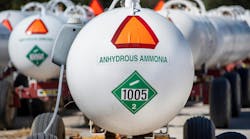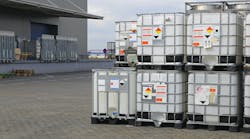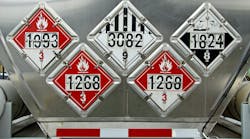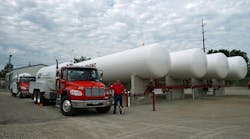A new safety alert from the Pipeline and Hazardous Materials Safety Administration (PHMSA) reminds shippers and carriers of the safety risks posed by the under-odorization of Liquefied Petroleum Gases (LPG). Under-odorization or odorant fade reportedly contributed to several recent LPG incidents.
PHMSA officials say the agency is aware of several incidents possibly attributed to either the under-odorization or odorant fade of LPG. Most notable of these incidents is one that happened in Norfolk MA on July 30, 2010 where an explosion occurred at a residential condominium complex that was under construction.
Emergency responders from 21 cities/towns deployed personnel to the accident site. The accident resulted in seven injuries and one fatality. The subsequent investigation raised questions as to whether there was a sufficient level of odorant in the LPG contained in the on-site storage tanks.
In accordance with federal and state laws and regulations, LPG intended for use by non-industrial entities is generally required to be odorized, or stenched, to enable the detection of any unintended release or leak of the gas. LPG is highly flammable and dangerous to inhale in large quantities. The added odorant is a safety precaution that helps warn those in the area that a release of gas has occurred.
In the Norfolk incident, there appeared to be no warning--ie odorant smell--prior to the explosion that the on-site LPG storage tank was leaking. PHMSA has consulted with stakeholders from industry, fire fighter associations, and other regulatory agencies in order to better understand the root cause of incidents like the one in Norfolk.
Although additional research may be necessary in order to come to more definitive conclusions, PHMSA has identified situations in which the risks of under-odorization or odor fade are more likely to occur. These situations are outlined below along with recommendations to mitigate potential risk factors that might lead to preventable outcomes:
Injection process: On December 13, 2012, PHMSA met with representatives from the National Propane Gas Association (NPGA) to gain a better understanding of the LPG odorization process. During this meeting, representatives from the NPGA stated that the most common method for the odorization of LPG is through an automated system.
However, the NPGA also noted there are situations where the odorization process is manually performed. In situations where the injection process is not fully automated, the potential for human error may increase the possibility of under-odorization. PHMSA officials believe that the insufficient level of odorant in the LPG contained in the on-site storage tank involved in the Norfolk MA incident was likely a major contributing factor in restricting the ability of on-site personnel to readily detect the leak.
Therefore, in this safety alert, PHMSA recommends that when the odorization of LPG is being accomplished by a manual injection process, quality control checks should be conducted to ensure that the requisite amount of odorant is being injected. Additionally, PHMSA recommends that when odorization of LPG is automatically injected, equipment calibration checks should be periodically performed to ensure consistent injection levels of the required odorant.
New tanks or freshly cleaned tanks: During meetings with various stakeholders, several indicated that a phenomenon known as “odor fade” may be a problem when new or recently cleaned tanks are used. New or recently cleaned tanks may absorb the odorant into the metal shell of these tanks, thus limiting the effectiveness of the remaining odorant in the LPG.
Based on this concern, PHMSA recommend that persons who receive new or recently cleaned tanks be notified of this fact and that persons filling these tanks implement appropriate quality control measures to ensure that potential odorant fade is adequately addressed. Such quality control measures will ensure that when delivered to end users, the LPG has sufficient odorant to be detected should a leak occur.
Odorization standards: The odorization of LPG is addressed by a myriad of federal and state laws and regulations, as well as, by accepted industry standards and practices. When offered and transported in commerce, the HMR specifies that all LPG in cargo and portable tanks be effectively odorized using either 1.0 pound of ethyl mercaptan, 1.0 pound of thiopane, or 1.4 pounds of amyl mercaptan per 10,000 gallons of LPG, to indicate the presence of gas in the event of an unintended release or leak.
The hazardous materials regulations do not, however, require LPG to be odorized if odorization would be harmful in the use or further processing of the LPG, or if odorization will serve no useful purpose as a warning agent in such use or further processing. Essentially, this exception applies to LPG being transported to industrial end-users.
Although the HMR requires odorization of LPG in cargo tanks and portable tanks, there are no such requirements in the HMR for rail tank cars and cylinders. Therefore, in this safety alert, PHMSA recommends that all LPG transported in rail tank car tanks or cylinders be odorized in accordance with the requirements of Sec 173.315(b)(1), of the HMR, unless odorization would be harmful in the use or further processing of the LPG, or if odorization will serve no useful purpose as a warning agent in such use or further processing.









